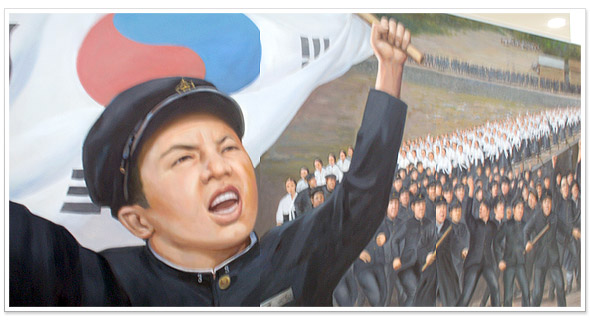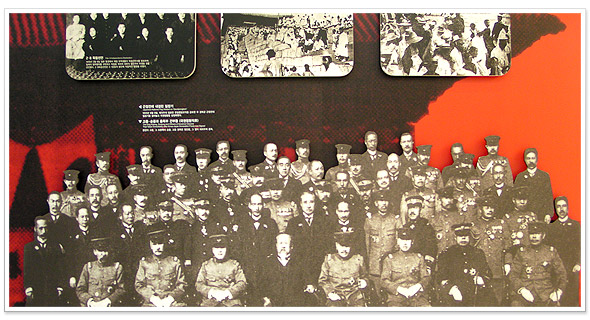Historical Significance
The Gwangju Student Independence Movement Memorial Hall is only a small incident where students of the Gwangju and Jeonnam districts resisted the oppression of the Japanese imperialists. However, this small movement spread into a nation-wide Anti-Japanese movement. The historical significance of the Gwangju Student Independence Movement is that this was where it all began.
 The anti-Japanese movement that slowly started among students from the early 1920s was sparked with the incident of the Korean girl being harassed at Naju Station on October 30, 1929 and an anti-Japanese protest was staged on November 3. This movement spread nationwide and it led not only students, but the entire nation to resist the violence of Japan. It can be said that the greatest significance of the Gwangju Student Independence Movement was that it awakened the noble spirit of our nation. The single drop that started in Gwangju spread throughout the nation, and then a wave of anti-Japanese movements began in China and within Japan as well. It can be said that it was a movement where a small drop turned into a great wave and awakened the spirit to resist injustice and to rekindle national pride.
The anti-Japanese movement that slowly started among students from the early 1920s was sparked with the incident of the Korean girl being harassed at Naju Station on October 30, 1929 and an anti-Japanese protest was staged on November 3. This movement spread nationwide and it led not only students, but the entire nation to resist the violence of Japan. It can be said that the greatest significance of the Gwangju Student Independence Movement was that it awakened the noble spirit of our nation. The single drop that started in Gwangju spread throughout the nation, and then a wave of anti-Japanese movements began in China and within Japan as well. It can be said that it was a movement where a small drop turned into a great wave and awakened the spirit to resist injustice and to rekindle national pride.
The Gwangju Student Independence Movement was not a coincidental incident where Korean students and Japanese students faced off against each other in Gwangju. Starting with the March 1 Movement, civil forces made up of students, farmers and laborers, who were at the heart of the anti-Japanese independence movement, made underground associations under the deceitful cultural policies and oppression the Japanese imperialists, and executed walkouts, sharecropping walkouts, and other strikes to heighten their anti-Japanese sentiment and organizational power. As the nation’s capacity for anti-Japanese movements matured, the student independence movement was stirred up.
 In the student independence movement of November 3, students who were the leading intellectuals of society at the time, played the key role of leading the national movement through its superior organizational power and passion, and its organization grew with the addition of social and young men’s association such as the Shinganhoe, Joseon Youth Association, and the Joseon Student Chonwi Alliance. The student independence movement, which developed into a nationwide anti-Japanese national movement, continued for five months and was joined by over 54,000 students in different schools and grades. This spread overseas as well, and led to rallies and ‘manse (hurray)’ demonstrations in the Jiandao and Jilin of Manchu, Shanghai and Beijing and China, as well as within Japan and the US. The spirit of the student independence movement was passed down and continued to various secret organizations, the resistance movement to the forceful conscription and collection of food by the government in the 1940s, and anti-J
apa
nese movements such as the 2nd Gwangju Student Independence Movement in May of 1943.
In the student independence movement of November 3, students who were the leading intellectuals of society at the time, played the key role of leading the national movement through its superior organizational power and passion, and its organization grew with the addition of social and young men’s association such as the Shinganhoe, Joseon Youth Association, and the Joseon Student Chonwi Alliance. The student independence movement, which developed into a nationwide anti-Japanese national movement, continued for five months and was joined by over 54,000 students in different schools and grades. This spread overseas as well, and led to rallies and ‘manse (hurray)’ demonstrations in the Jiandao and Jilin of Manchu, Shanghai and Beijing and China, as well as within Japan and the US. The spirit of the student independence movement was passed down and continued to various secret organizations, the resistance movement to the forceful conscription and collection of food by the government in the 1940s, and anti-J
apa
nese movements such as the 2nd Gwangju Student Independence Movement in May of 1943.
Despite its major historical significance, the student independence movement of November 3 is still not receiving its fair attention. Thus, most people understand this movement to be an incident that occurred by chance between Korean and Japanese students in a limited area of Gwangju.
Moreover, many people know November 3 simply as a ‘memorial day for student independence movements’. We should now see the Gwangju Student Independence Movement as a general national movement so that it can be properly identified socially and receive its due credit.


1. November 3 Gwangju Student Independence Movement
The student independence movement that started in Gwangju on November 3, 1929 and spread nationwide, was one of the best known national movements that resisted the rule of Japanese imperialism, and taking into account its scale, effects, and historical significance, it was an anti-Japanese independence movement that was as important as the March 1 Movement. The Gwangju Student Independence Movement was not a coincidental incident where Korean students and Japanese students faced off against each other in Gwangju. Starting with the March 1 Movement, civil forces made up of students, farmers and laborers, who were at the heart of the anti-Japanese independence movement, made underground associations under the deceitful cultural policies and oppression the Japanese imperialists, and executed walkouts, sharecropping walkouts, and other strikes to heighten their anti-Japanese sentiment and organizational power. As the nation’s capacity for anti-Japanese movements matured, the student independence movement was stirred up.

Despite its major historical significance, the student independence movement of November 3 is still not receiving its fair attention. Thus, most people understand this movement to be an incident that occurred by chance between Korean and Japanese students in a limited area of Gwangju.
Moreover, many people know November 3 simply as a ‘memorial day for student independence movements’. We should now see the Gwangju Student Independence Movement as a general national movement so that it can be properly identified socially and receive its due credit.
2. Emblem of the Gwangju Student Independence Movement


